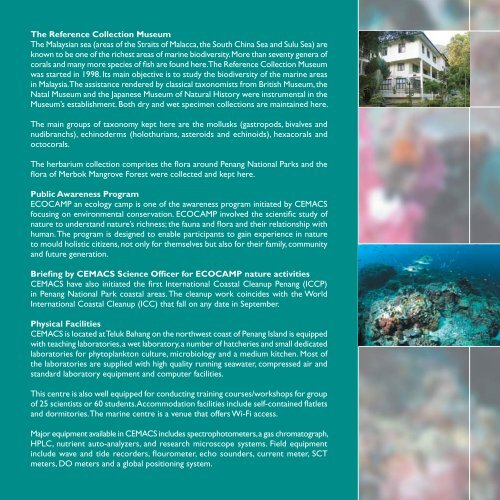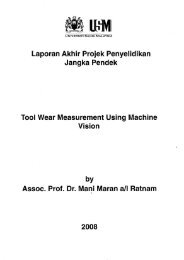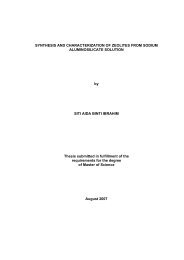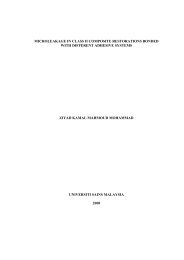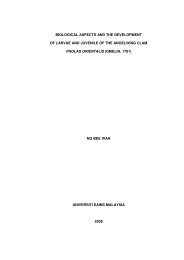Research Institutes, Centres and Units - Universiti Sains Malaysia
Research Institutes, Centres and Units - Universiti Sains Malaysia
Research Institutes, Centres and Units - Universiti Sains Malaysia
You also want an ePaper? Increase the reach of your titles
YUMPU automatically turns print PDFs into web optimized ePapers that Google loves.
The Reference Collection Museum<br />
The <strong>Malaysia</strong>n sea (areas of the Straits of Malacca, the South China Sea <strong>and</strong> Sulu Sea) are<br />
known to be one of the richest areas of marine biodiversity. More than seventy genera of<br />
corals <strong>and</strong> many more species of fish are found here. The Reference Collection Museum<br />
was started in 1998. Its main objective is to study the biodiversity of the marine areas<br />
in <strong>Malaysia</strong>. The assistance rendered by classical taxonomists from British Museum, the<br />
Natal Museum <strong>and</strong> the Japanese Museum of Natural History were instrumental in the<br />
Museum’s establishment. Both dry <strong>and</strong> wet specimen collections are maintained here.<br />
The main groups of taxonomy kept here are the mollusks (gastropods, bivalves <strong>and</strong><br />
nudibranchs), echinoderms (holothurians, asteroids <strong>and</strong> echinoids), hexacorals <strong>and</strong><br />
octocorals.<br />
The herbarium collection comprises the flora around Penang National Parks <strong>and</strong> the<br />
flora of Merbok Mangrove Forest were collected <strong>and</strong> kept here.<br />
Public Awareness Program<br />
ECOCAMP an ecology camp is one of the awareness program initiated by CEMACS<br />
focusing on environmental conservation. ECOCAMP involved the scientific study of<br />
nature to underst<strong>and</strong> nature’s richness; the fauna <strong>and</strong> flora <strong>and</strong> their relationship with<br />
human. The program is designed to enable participants to gain experience in nature<br />
to mould holistic citizens, not only for themselves but also for their family, community<br />
<strong>and</strong> future generation.<br />
Briefing by CEMACS Science Officer for ECOCAMP nature activities<br />
CEMACS have also initiated the first International Coastal Cleanup Penang (ICCP)<br />
in Penang National Park coastal areas. The cleanup work coincides with the World<br />
International Coastal Cleanup (ICC) that fall on any date in September.<br />
Physical Facilities<br />
CEMACS is located at Teluk Bahang on the northwest coast of Penang Isl<strong>and</strong> is equipped<br />
with teaching laboratories, a wet laboratory, a number of hatcheries <strong>and</strong> small dedicated<br />
laboratories for phytoplankton culture, microbiology <strong>and</strong> a medium kitchen. Most of<br />
the laboratories are supplied with high quality running seawater, compressed air <strong>and</strong><br />
st<strong>and</strong>ard laboratory equipment <strong>and</strong> computer facilities.<br />
This centre is also well equipped for conducting training courses/workshops for group<br />
of 25 scientists or 60 students. Accommodation facilities include self-contained flatlets<br />
<strong>and</strong> dormitories. The marine centre is a venue that offers Wi-Fi access.<br />
Major equipment available in CEMACS includes spectrophotometers, a gas chromatograph,<br />
HPLC, nutrient auto-analyzers, <strong>and</strong> research microscope systems. Field equipment<br />
include wave <strong>and</strong> tide recorders, flourometer, echo sounders, current meter, SCT<br />
meters, DO meters <strong>and</strong> a global positioning system.


